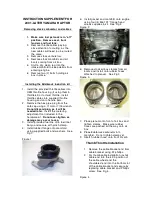
1–26 SEATS AND OCCUPANT PROTECTION SYSTEMS
In a crash, a vehicle may go from high-
way speed to a full stop in a fraction
of a second and in a distance of less
than one foot. This extremely short stop-
ping time and distance greatly increases
the force placed upon the occupants. No
person has the strength or reflexes to
counteract this force. Even occupants
properly positioned and wearing their
safety belts will find their head, upper
torso, arms, and hips thrown forward
at the speed the vehicle was traveling
before impact. In moderate to severe
frontal collisions, even occupants wear-
ing safety belts can sustain internal
brain and organ injuries without the
occupant’s head or torso hitting any sta-
tionary objects or surfaces.
Air bags provide additional stopping
time and distance for the head and up-
per torsos of front occupants in moder-
ate to severe frontal or near-frontal col-
lisions. This additional time and dis-
tance can save lives and prevent seri-
ous injuries.
All of these injuries are caused by the
force created by the collision as the ve-
hicle is brought to a sudden stop. The
time and distance which a vehicle is al-
lowed in slowing or stopping in great
part determines the severity of a
collision’s effect on vehicle occupants.
For example, when a vehicle brakes to
a stop at a red light, the occupant’s bod-
ies are forced forward. This is because
both the vehicle and its occupants are
initially traveling at the same speed.
The brakes slow the vehicle, and the oc-
cupants continue to move forward
somewhat inside the vehicle. However,
properly positioned and restrained oc-
cupants are rarely injured when a ve-
hicle comes to a stop by even sudden
and hard braking. This is because even
hard braking allows a comparatively
long time and distance for the vehicle
to stop. The safety belts and the occu-
pants’ strength are generally sufficient
to safely counteract the force of a brak-
ing stop.
HOW AIR BAGS PROTECT FRONT
OCCUPANTS
Vehicle occupants are usually injured in
a collision because their bodies are
thrown into a stationary object, either
inside the vehicle, such as the steering
wheel, instrument panel or windshield,
or outside the vehicle, such as the driv-
ing surface or a tree, when the occupant
is thrown from the vehicle. Severe in-
juries also occur by occupants being
jolted by the forces of the crash, even
without body contact with a stationary
object or surface.
S3W1241A
Содержание Kalos
Страница 4: ......
Страница 34: ......
Страница 78: ......
Страница 251: ...VEHICLEMAINTENANCE 7 1 GENERAL INFORMATION 7 2 VEHICLE MAINTENANCE SEVERE CONDITIONS 7 2 7 ...
Страница 264: ......
Страница 265: ...INDEX 9 1 INDEX 9 ...
Страница 270: ......
















































